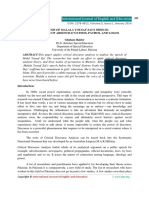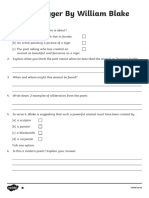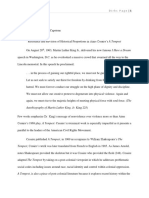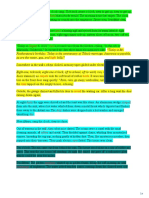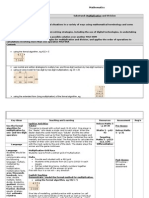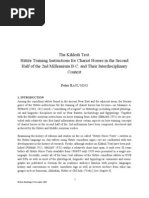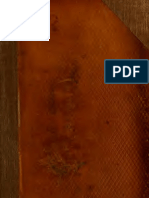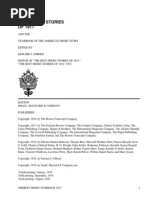Flanders Fields
Flanders Fields
Uploaded by
api-267136654Copyright:
Available Formats
Flanders Fields
Flanders Fields
Uploaded by
api-267136654Original Title
Copyright
Available Formats
Share this document
Did you find this document useful?
Is this content inappropriate?
Copyright:
Available Formats
Flanders Fields
Flanders Fields
Uploaded by
api-267136654Copyright:
Available Formats
q
Commemoration Poppies
In Flanders fields
POPPIES
Visit the Australian War Memorial on almost any day and one of the most moving sights will be the hundreds of
poppies wedged into crevices on the Roll of Honour. The bright red poppies provide a visual counterpoint to the
sombre grey of panels, yet each poppy reminds us that, here, someone has remembered the sacrifice and service in
time of war of one of Australias servicemen or women.
WHY POPPIES ?
Since the First World War, the poppy has been a symbol of remembrance. All along the Western Front between 1914
and 1918, amid the ruin wrought by shells, the poppies of Flanders bloomed across the devastated landscape. Some
saw in the flowers a return of life to the earth, despite the hundreds of thousands of dead buried in the countryside.
It is known that poppies flourish in disturbed soil the shelling by the large artillery guns may have broken up the
earth to such an extent that the conditions for the growth of poppies were at their best during those terrible years.
At the time, many French and Belgian citizens said they could not remember ever seeing such a magnificent show
of poppies, but equally war weariness may have heightened the magnificence in the eyes of the survivors.
IN FLANDERS FIELDS
Close by the Essex Farm Cemetery, near the Belgian town of Ieper (Ypres), are some dugouts that in May 1915
were occupied by men of the First Brigade Artillery, Canadian Army. About them raged the second battle of Ypres,
in which the Germans used poison gas for the first time on the Western Front. The brigades medical officer, Major
John McCrae, frequently visited the grave of his friend, Lieutenant A.H. Helmer, who was buried with other allied
war dead in the nearby cemetery. It was supposedly during one of these visits that some of the most popular verses
of poetry penned during the First World War were conceived, literally born of blood and fire during the hottest
phase of the battle.
The poem, In Flanders fields, first appeared anonymously in the English magazine, Punch, on 8 December 1915, but
it was soon recognised as McCraes work. The poem spread quickly throughout the British Commonwealth and it
was used in connection with a Poppy Fund in England in 1916. McCrae died of pneumonia on 28 January 1918 at
Boulogne, on the coast of France, and was buried in the Wimereux Military Cemetery.
In 1918, an American YMCA worker, after reading McCraes poem, wore a poppy to keep the faith. So began the
tradition of wearing poppies on Armistice (later Remembrance) Day as a tribute to the dead. In Australia, poppies
are also worn on ANZAC Day.
Above: A. Henry Fullwood, 5th Division staff officers at Coisy viewing Amiens being shelled (1918, watercolour and gouache with charcoal,
39.3 x 56.8 cm, AWM ART 02466)
55
Commemoration Poppies / The Ode
(Left) Visitors to the Memorial search
for names on the Roll of Honour,
poignantly decorated by bright red
Flanders poppies.
The Returned Sailors and
Soldiers Imperial League of
Australia (now the Returned
and Services League of Australia,
or RSL) first sold poppies in
about 1921 as a reminder of the
war dead and to raise funds for
its charity work. Since then,
wearing a poppy has helped
Australians to show, in a practical way, their support for the voluntary work being done
to assist those damaged in body and mind by war. To wear a
poppy is also a token of remembrance for the more than 100,000
Australian servicemen and women who have died in war.
In Flanders fields the poppies blow
Between the crosses, row on row
That mark our place; and in the sky
The larks, still bravely singing, fly
Scarce heard amid the guns below.
We are the Dead. Short days ago
We lived, felt dawn, saw sunset glow,
Loved and were loved, and now we lie
In Flanders fields.
Take up our quarrel with the foe;
To you from failing hands we throw
The torch, be yours to hold it high.
If ye break faith with us who die
We shall not sleep though poppies grow
In Flanders fields.
John McCrae
Robert Pounds Department of Veterans Affairs
Flanders Poppies
The Red Flanders Poppy, Papaver rhoeas, is the
poppy to which John McCrae refers in his poem.
The plant is a hardy annual which grows to about
50 cm tall. It likes a sunny position protected from
wind, and well drained soil turned to a fine tilth.
In compacted soil, the seeds can lie dormant. Earlier
this year, as part of its schools ANZAC Day pack,
the Department of Veterans Affairs provided a
packet of Flanders Poppy seeds to every school
in Australia. To establish your own remembrance
patch of Flanders poppies in your garden, check
your local garden supplier for seeds or seedlings.
56
The Ode
is it condemn or contemn?
Every year, after ANZAC Day and Remembrance Day,
letters to the editor appear in newspapers and magazines,
asking about The Ode:
They shall grow not old, as we that are left grow old:
Age shall not weary them, nor the years condemn.
At the going down of the sun and in the morning
We will remember them.
The issue raised by most letters is whether the last word
of the second line should be condemn or contemn.
Contemn means to despise or treat with disregard,
so both words fit the context.
The four lines quoted above, along with Kiplings lines
from the Recessional hymn Lest we forget are now
generally known as The ode of remembrance. They are the
fourth stanza of the poem, For the fallen, by Laurence
Binyon, and were written in the very early days of the
First World War.
Binyon was the Assistant Keeper of Prints and Drawings
at the British Museum, and a respected and published poet.
He was not a soldier, though he did work in France as
a volunteer in a field hospital or first aid station during
his annual leave. A week after war broke out, Binyon had
his first war poem, The fourth of August, published in The
Times. Here he was confident and optimistic, writing of
the Spirit of England, ardent-eyed. But by September
1914, when For the fallen was published, the British
Expeditionary Force in France was suffering severe casualties. Each day, long lists of the dead and wounded
appeared in British newspapers.
Binyon had actually written the poem some weeks earlier,
just after the retreat from Mons began in August 1914,
when the British Expeditionary Force had become the
first British army to fight on western European soil since
Waterloo. The four central lines that now make up the
fourth verse were the first part of the poem Binyon
composed: he wrote them while sitting on a cliff at Polseath,
Cornwall. In finding a language and a rhythm for the
poem, he drew on Shakespeare especially Enobarbus
lines on Cleopatra, Age cannot wither her, nor custom
stale and the Bible: I wanted to get a rhythm something like By the waters of Babylon we sat down and wept
or Daughters of Jerusalem, weep not for me.
For the fallen was first published on 21 September 1914
in The Times. By the end of the year, the British
composer, Edward Elgar, was setting a number of Binyons
poems, including For the fallen, to music, in a cycle called
The spirit of England.
The only mystery is where the claim for contemn may
have originated. There is no evidence for another story
sometimes repeated that Binyon wrote to several poets
after the poem was first published, seeking their views on
whether the word should be condemn or contemn,
and only settled on condemn in 1921. He had always
intended the word to be condemn.
The alternative contemn seems to be a peculiarly
Australian phenomenon. There does not appear to have
been any dispute on this matter in Britain, Canada, or the
USA. In Australia, both the RSL and the Australian War
Memorial use condemn in their ceremonies. We may
not know where the confusion arose, but surely it is now
time to put the matter to rest.
Robert Pounds Department of Veterans Affairs
Composed in Cornwall as Binyon sat with Cicely [his
wife] gazing out over the ocean, this most public of
quatrains is, like the poem that grew from it, deliberately
choric, so densely laminated with allusions that the poet
recedes into anonymity, allowing the literature-saturated
English language to speak for itself.
John Hatcher, biographer of Laurence Binyon
For the fallen
With proud thanksgiving, a mother for her children,
England mourns her dead across the sea.
Flesh of her flesh they were, spirit of her spirit,
Fallen in the cause of the free.
Commemoration The Ode
To return to the question of whether the last word of the
second line should be condemn or contemn, it is clear
that condemn is correct. The word appeared in that
form in The Times on 21 September 1914, in Elgars libretto
a few months later, and in a collection of Binyons poems,
The winnowing fan, published in December 1914. According
to Dr Christopher Fletcher, the curator of modern history
manuscripts at the British Library, the Library holds a copy
of the whole poem and another of only the fourth stanza
in Binyons own handwriting, and both show condemn.
Indeed, a copy of the fourth stanza in Binyons hand was
published in Australia in Reveille in August 1943: again
it reads condemn. Binyon was very precise in his use
of words: there is no doubt that if he had intended
contemn then he would have used it.
Solemn the drums thrill; Death august and royal
Sings sorrow up unto immortal spheres.
There is music in the midst of desolation
And glory that shines upon our tears.
They went with songs to battle, they were young,
Straight of limb, true of eye, steady and aglow.
They were staunch to the end against odds uncounted;
They fell with their faces to the foe.
They shall grow not old, as we that are left grow old:
Age shall not weary them, nor the years condemn.
At the going down of the sun and in the morning
We will remember them.
They mingle not with their laughing comrades again;
They sit no more at familiar tables of home;
They have no lot in our labour of the day-time;
They sleep beyond Englands foam.
But where our desires are and our hopes profound,
Felt as a well-spring that is hidden from sight,
To the innermost heart of their own land they are known,
As the stars are known to the Night;
As the stars that shall be bright when we are dust,
Moving in marches upon the heavenly plain;
As the stars that are starry in the time of our darkness,
Above: Students and teachers of Kensington Public School, NSW, stand
at the Tomb of the Unknown Australian Soldier while one of their number
reads The Ode. Readings of this type are conducted by schoolchildren
To the end, to the end, they remain.
Laurence Binyon
every week at the Memorial. (AWM PAIU 1999/26/06)
57
You might also like
- DiggingDocument11 pagesDiggingMohammad AjajNo ratings yet
- The Great Emu WarDocument5 pagesThe Great Emu WarAnonymous yCpjZF1rFNo ratings yet
- The Great Emu WarDocument3 pagesThe Great Emu Warbrooklyn100% (1)
- Scarlet Ibis Test and EssayDocument1 pageScarlet Ibis Test and EssayVirginia WarfieldNo ratings yet
- War Front World War One Gallery Walk Classwork SheetDocument3 pagesWar Front World War One Gallery Walk Classwork SheetTara MorganNo ratings yet
- Peter and The Wolf 2 PPPDocument36 pagesPeter and The Wolf 2 PPPinma.I.classNo ratings yet
- Copper Sun Chapterby Chapter Discussion QuestionsDocument6 pagesCopper Sun Chapterby Chapter Discussion QuestionsDaniel AlanNo ratings yet
- Sonnet 30 AnnotationDocument1 pageSonnet 30 AnnotationKatelin Lucine100% (1)
- Year 5 t1 Unit 1Document5 pagesYear 5 t1 Unit 1api-267136654No ratings yet
- J Ulie: JulieDocument763 pagesJ Ulie: JulieLuiza100% (1)
- Beautiful Poems: Members: Ardelia Dinda Ivana Yasyvieni Nooranita Xi-Ips 2Document16 pagesBeautiful Poems: Members: Ardelia Dinda Ivana Yasyvieni Nooranita Xi-Ips 2PoernomoNo ratings yet
- Defining Poetry and Characteristics of Poetry PDFDocument74 pagesDefining Poetry and Characteristics of Poetry PDFEcila DigoNo ratings yet
- A Poison Tree by William BlakeDocument8 pagesA Poison Tree by William BlakeChong Mui Fong100% (1)
- By Maya Angelou: Still I RiseDocument3 pagesBy Maya Angelou: Still I RiseN. Huey HueyNo ratings yet
- Figurative Language Lesson PlanDocument4 pagesFigurative Language Lesson PlanSadie Hannah0% (1)
- The Great War - Causes: Home US History IB History Professional Soccer History ProjectsDocument4 pagesThe Great War - Causes: Home US History IB History Professional Soccer History ProjectsKateGalvanNo ratings yet
- The Cantebury TalesDocument21 pagesThe Cantebury TalesMusat LuizaNo ratings yet
- Valentine by Carol Ann Duffy: Made by Ardaan BhatiaDocument11 pagesValentine by Carol Ann Duffy: Made by Ardaan BhatiaArdaan BhatiaNo ratings yet
- Poetic Devices Part 1Document7 pagesPoetic Devices Part 1Abdulrahman BaderNo ratings yet
- Julius Caesar Anticipation Guide Name: - Evan Jack - DateDocument2 pagesJulius Caesar Anticipation Guide Name: - Evan Jack - DateEvan JackNo ratings yet
- International Journal of English and EducationDocument15 pagesInternational Journal of English and EducationMouna Ben GhanemNo ratings yet
- The Tyger: William BlackDocument18 pagesThe Tyger: William BlacksaidNo ratings yet
- What A Wonderful WorldDocument11 pagesWhat A Wonderful WorldRafelle SteenaNo ratings yet
- Week 10 11 - The Crucible Fences Print EeDocument14 pagesWeek 10 11 - The Crucible Fences Print Eeapi-372938135No ratings yet
- The GlobeDocument5 pagesThe GlobektNo ratings yet
- The Passionate Shepherd To His Love: Christopher MarloweDocument17 pagesThe Passionate Shepherd To His Love: Christopher MarloweNikka Jean Duero LachicaNo ratings yet
- Fundamentals of PoetryDocument23 pagesFundamentals of PoetryA. Garcia100% (1)
- Rita Joe I Lost My TalkDocument2 pagesRita Joe I Lost My Talkapi-39473323250% (2)
- Her Story .. and VisionDocument23 pagesHer Story .. and VisionJeunifer NiaNo ratings yet
- Grade 7 Tom Sawyer Close Reading Exemplar-1 PDFDocument12 pagesGrade 7 Tom Sawyer Close Reading Exemplar-1 PDFRegina PalisocNo ratings yet
- Wilfred OwenDocument10 pagesWilfred OwennatalieNo ratings yet
- My ParentsDocument2 pagesMy ParentsA personNo ratings yet
- Reading Comprehension Activity Tyger TygerDocument8 pagesReading Comprehension Activity Tyger TygerRenuga I. KuppusamyNo ratings yet
- Poetry Unit 2Document7 pagesPoetry Unit 2Vian100% (1)
- The Legacy of William ShakespeareDocument5 pagesThe Legacy of William ShakespearedraxlerNo ratings yet
- FutilityDocument3 pagesFutilityCleo MunroNo ratings yet
- Music Memory GlossaryDocument10 pagesMusic Memory Glossaryapi-351173146No ratings yet
- Hesperides or The Works Both Human and Divine With 1200 Poems Book of Sports, Issued by James I inDocument2 pagesHesperides or The Works Both Human and Divine With 1200 Poems Book of Sports, Issued by James I inannaNo ratings yet
- Significant Events ww1Document2 pagesSignificant Events ww1api-444176564No ratings yet
- Compare and Contrast The Presentation of Memory in Your Chosen PoemsDocument2 pagesCompare and Contrast The Presentation of Memory in Your Chosen PoemsKirusaanth SathiyathasanNo ratings yet
- SestinaDocument8 pagesSestinaChelle BelenzoNo ratings yet
- Eng 490 CapstoneDocument25 pagesEng 490 Capstoneapi-383939636No ratings yet
- Poetry Analysis-Lesson 6 (23 April 2021)Document26 pagesPoetry Analysis-Lesson 6 (23 April 2021)Zainal AthoNo ratings yet
- Using Katy Perry S Firework To Identify Figurative Language Poetry Devices PDFDocument3 pagesUsing Katy Perry S Firework To Identify Figurative Language Poetry Devices PDFjelenaNo ratings yet
- PoetryDocument21 pagesPoetryFarah MudrikahNo ratings yet
- English I Lyric AnalysisDocument2 pagesEnglish I Lyric Analysisapi-242650726No ratings yet
- History of The Hmong - A Timeline: - PrehistoryDocument2 pagesHistory of The Hmong - A Timeline: - PrehistoryErica YajNo ratings yet
- The Highway Man. Lesson - AnthologyDocument11 pagesThe Highway Man. Lesson - AnthologyJordan Hugh SamNo ratings yet
- 7 - There Will Come Soft Rains by Ray BradburyDocument5 pages7 - There Will Come Soft Rains by Ray BradburySebastian castañedaNo ratings yet
- 2018 HSC Modern History MG PDFDocument16 pages2018 HSC Modern History MG PDFAmelia RahmawatiNo ratings yet
- Wilfre OwenDocument21 pagesWilfre Owenapi-293260528No ratings yet
- The Plight of Stolen Generation in Jane Harrisons StolenDocument7 pagesThe Plight of Stolen Generation in Jane Harrisons Stolenapi-302447167No ratings yet
- Written Composition Rubric 2018Document1 pageWritten Composition Rubric 2018Luis MartinezNo ratings yet
- There Will Come Soft Rains: Previewing TextsDocument4 pagesThere Will Come Soft Rains: Previewing TextsNatella ManafovaNo ratings yet
- A Poison TreeDocument5 pagesA Poison TreeElaine Chin100% (1)
- World War I Poetry: - Patriotism - Heroism - War and Nature - Visions and DreamsDocument23 pagesWorld War I Poetry: - Patriotism - Heroism - War and Nature - Visions and DreamsBarbara Concu100% (1)
- World War One British Poets: Brooke, Owen, Sassoon, Rosenberg and OthersFrom EverandWorld War One British Poets: Brooke, Owen, Sassoon, Rosenberg and OthersRating: 4.5 out of 5 stars4.5/5 (32)
- Tesina IngleseDocument4 pagesTesina InglesesimoneballelliNo ratings yet
- World War 1 Poems and Excerpts From Norton AnthologyDocument42 pagesWorld War 1 Poems and Excerpts From Norton AnthologyANKIT KUMAR DUBEYNo ratings yet
- The War Poets MonoDocument40 pagesThe War Poets MonoAsma AmjadNo ratings yet
- Georgian and War PoetryDocument10 pagesGeorgian and War PoetryAnita TołkinNo ratings yet
- Tenambit Ps Maths Key Ideas Ass Yr5 t2Document3 pagesTenambit Ps Maths Key Ideas Ass Yr5 t2api-267136654No ratings yet
- Year 6 T2u3 Mathematics TermDocument6 pagesYear 6 T2u3 Mathematics Termapi-267136654No ratings yet
- Year 6 t1 Unit 3 Mathematics TermDocument6 pagesYear 6 t1 Unit 3 Mathematics Termapi-267136654No ratings yet
- Year 6 T2u5Document5 pagesYear 6 T2u5api-267136654No ratings yet
- Editing t2-2Document22 pagesEditing t2-2api-267136654No ratings yet
- Year 5 t1 Unit 9Document6 pagesYear 5 t1 Unit 9api-267136654No ratings yet
- Year 6 t1 Unit1 Mathematics TermDocument5 pagesYear 6 t1 Unit1 Mathematics Termapi-267136654No ratings yet
- Year 5 t1 Unit 7Document4 pagesYear 5 t1 Unit 7api-267136654No ratings yet
- Year 5 t1 Unit 6Document10 pagesYear 5 t1 Unit 6api-267136654No ratings yet
- Year 5 t1 Unit 4Document8 pagesYear 5 t1 Unit 4api-267136654No ratings yet
- Year 6 Mathematics Term 2 Unit 1Document5 pagesYear 6 Mathematics Term 2 Unit 1api-267136654No ratings yet
- Year 5 Mathematics Portfolio AboveDocument34 pagesYear 5 Mathematics Portfolio Aboveapi-267136654No ratings yet
- Teaching Measurement s2 and s3 Volume and Capacity and MassDocument64 pagesTeaching Measurement s2 and s3 Volume and Capacity and Massapi-267136654No ratings yet
- Year 5 t2 Unit 3 Bolwarra Ps 3Document5 pagesYear 5 t2 Unit 3 Bolwarra Ps 3api-267136654No ratings yet
- Can You Cut It AssessmentDocument1 pageCan You Cut It Assessmentapi-267136654No ratings yet
- Can You Cut It Assessment Answer KeyDocument2 pagesCan You Cut It Assessment Answer Keyapi-267136654No ratings yet
- Life Cycle of A Frog: Cute Craftivity WheelDocument20 pagesLife Cycle of A Frog: Cute Craftivity Wheelapi-267136654No ratings yet
- Peter Raulwing The Kikkuli Text Master File Dec 2009Document21 pagesPeter Raulwing The Kikkuli Text Master File Dec 2009최두영No ratings yet
- Intentions in The Experience of Meaning - GibbsDocument0 pagesIntentions in The Experience of Meaning - GibbsInbal ReshefNo ratings yet
- English Part 1Document3 pagesEnglish Part 1Zuetrix PhoenizNo ratings yet
- Language MattersDocument209 pagesLanguage MattersitzhakbirdNo ratings yet
- OzymandiasDocument19 pagesOzymandiasNokukhanya HlabanganaNo ratings yet
- Great American Bestsellers (Starter)Document3 pagesGreat American Bestsellers (Starter)ressmyNo ratings yet
- Anthropology and Literature GeertzDocument10 pagesAnthropology and Literature Geertzmarc1895No ratings yet
- Asiaticresearche 02 AsiaDocument524 pagesAsiaticresearche 02 Asiasjohar100% (1)
- A Brief Excerpt From Jan Fries' The Cauldron of The Gods (Mandrake Oxford, 2003)Document1 pageA Brief Excerpt From Jan Fries' The Cauldron of The Gods (Mandrake Oxford, 2003)Pēteris CedriņšNo ratings yet
- Shifts in Songs The Cover Versions of English Popular Song Into JavaneseDocument19 pagesShifts in Songs The Cover Versions of English Popular Song Into JavaneseIkke PratamaNo ratings yet
- CBSE Class 12 English An Elementary School Classroom in A SlumDocument2 pagesCBSE Class 12 English An Elementary School Classroom in A Slumshivam tiwariNo ratings yet
- Sight of Sound in Chinese PaintingDocument27 pagesSight of Sound in Chinese PaintingbiancaknowlesNo ratings yet
- William Wordsworths Love To NatureDocument2 pagesWilliam Wordsworths Love To NatureInpoc shlomiNo ratings yet
- Cycle of The Sun and The Moon Croup 1Document27 pagesCycle of The Sun and The Moon Croup 1RoseLie Ma Llorca BlancaNo ratings yet
- Classical Poetry by SajidDocument1 pageClassical Poetry by SajidAdv Faiz ShahzadNo ratings yet
- The Revolt of The MassesDocument1 pageThe Revolt of The MassesAinz GownNo ratings yet
- Lit Sample EssaysDocument6 pagesLit Sample EssaysJonathanNo ratings yet
- BA NEP Time Table 1,3 & 5 SemDocument7 pagesBA NEP Time Table 1,3 & 5 Semvijay patilNo ratings yet
- Rkyv Online #53Document60 pagesRkyv Online #53Randy Paré100% (1)
- English Literature: Insight ReportDocument12 pagesEnglish Literature: Insight ReportAbdelrahman TabashNo ratings yet
- Timeline of British LiteratureDocument2 pagesTimeline of British LiteratureMichelle RangesNo ratings yet
- Joseph CampbellDocument21 pagesJoseph Campbelldavebluez100% (8)
- MacDowell-Aristophanes and Athens An Introduction To The Plays by Douglas Maurice MacDowellDocument374 pagesMacDowell-Aristophanes and Athens An Introduction To The Plays by Douglas Maurice MacDowellmavaldesguia100% (1)
- Diogenes and AlexanderDocument4 pagesDiogenes and AlexanderadammendisNo ratings yet
- LMT100 Students IPDocument5 pagesLMT100 Students IPMike FaaNo ratings yet
- Bulleh Shah Poem 105,106Document4 pagesBulleh Shah Poem 105,106gharuneetuNo ratings yet
- THE Best Short Stories OF 1917Document397 pagesTHE Best Short Stories OF 1917Gutenberg.org100% (3)
- Psychological NovelDocument6 pagesPsychological NovelMrinmoyee MannaNo ratings yet
- Deadly Little Secret Discussion GuideDocument4 pagesDeadly Little Secret Discussion GuideDisney HyperionNo ratings yet




















